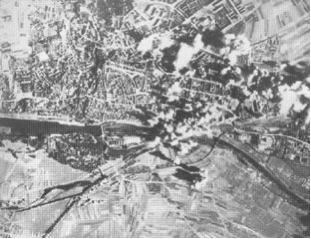Aerial photograph of ball-bearing factories at Schweinfurt.
Trips into big cities were dangerous because of Allied bombing. During trips into Schweinfurt in April and July 1944, Tonkin was caught in bombing raids. Both times he and his escort were forced into a shelter where German civilians noticed Tonkin’s British battle dress and became agitated. Tonkin feared he would be attacked. Deciding discretion was the better part of valour, he waited outside during the raid while his German escort stayed in the shelter.
By September 1944, the Allies had gained air superiority and intelligence could be gathered by aircraft, so the nature of Tonkin’s work changed. Propaganda messages such as ‘surrender’ were to be painted on walls and there were instructions on how to keep POWs off the roads so not to obstruct the Allied armies.
In late September after an altercation with a Gestapo captain at Ebelsbach railway station, Tonkin was cautioned by the hospital commandant and sent back to Stalag XIII C. When the prison camp was liberated by the 47th United States Tank Battalion on 6 April 1945 the guards had already left. Tonkin and several others departed two days later and by hitch hiking and flying with the US and Canadian air forces they arrived on 11 April in London. Tonkin travelled back to Australia arriving in Sydney in June and was discharged the following month. In February 1946 Tonkin was Mentioned in Despatches in recognition of gallant and distinguished services in the field.
Tonkin was one of many Allied POWs who worked in small groups to gathered intelligence against the Germans. If caught, they risked severe punishment or even death but were still determined to do their bit against Nazi Germany.
[1] C. J. E Rae, A.L Harris, and R. K Bryant, On target : the story of the 2/3rd Australian Light Anti-Aircraft Regiment from formation on 18th July, 1940 until disbandment on 14th July, 1943, and the subsequent service of 7th Battery, 8th Battery, and 9th Battery, until the end of World War II. 2/3rd Australian Light Anti-Aircraft Regiment Association, (Victoria, 1987) p41.
[2]Gavin Long, Australia in the War of 1939-45 Army; Greece, Crete and Syria. (Canberra, Australian War Memorial, 1953) p221.
[3] C. J. E Rae, A.L Harris, and R. K Bryant, On target : the story of the 2/3rd Australian Light Anti-Aircraft Regiment, p 79
Further Reading
Greville, Howard. Prison Camp Spies: Intelligence Gathering Behind the Wire. (Loftus, NSW, Australian Military History Publications, 1998).
Long , Gavin. Australia in the War of 1939-45 Army; Greece, Crete and Syria. (Canberra, Australian War Memorial, 1953).
Rae, C. J. E, Harris, A. L. and Bryant, R. K. On target : the story of the 2/3rd Australian Light Anti-Aircraft Regiment from formation on 18th July, 1940 until disbandment on 14th July, 1943, and the subsequent service of 7th Battery, 8th Battery, and 9th Battery, until the end of World War II. 2/3rd Australian Light Anti-Aircraft Regiment Association, (Victoria, 1987).
Tonkin, Rolstyn Nicholas. AWM PR03241.
Tonkin, Rolstyn Nicholas. NAA B883, VX37081.












